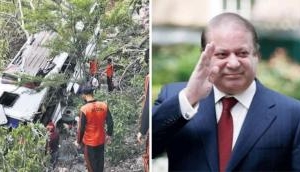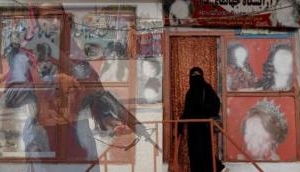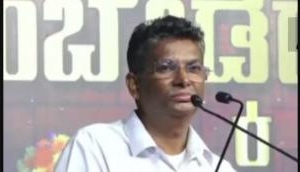
A decade after the fall of the monarchy, republican Nepal went through another year of political tumult with nothing to show at the end of it. Political gridlock persists, miseries of survivors of the April 2015 earthquake haven't abated, and jingoistic anti-India slogans are as popular among the chattering classes of Kathmandu as ever.
Rightly has it been said that the more things change, the more they remain the same, at least in ethnocentric societies where the dominant majority is deeply embedded in the status quo.
That nothing of note is happening in Nepal implies that decay and stasis have begun to peril its polity. The adage that no news is good news doesn't always apply. In transitional stages, changes have to be introduced even to maintain stability. Leaders have to take bold decisions without being afraid of making mistakes.
Also Read: Nepal has become a Hindu State through the backdoor
When questioned at a closed-door meeting last week, Pushpa Kamal Dahal aka Prachanda told a group of concerned citizens that his apparent inactivity was in fact a considered activity to enable the opposition leader KP Sharma Oli to expose his unreasonable obstinacy on key national issues in full view of the public. Coming from a prime minister who took office five months ago with the stated aim of putting the derailed political process back on track, his explanation sounds like a lame excuse.
The constitutional stalemate continues despite the promise of the ruling coalition to amend the charter. Madhesh-based parties, which have been campaigning against what they call "a regressive constitution", insist that the proposed amendments fall far short of their expectations.
The chief opposition party, on the other hand, insists that no change in the supreme law is either required or possible at this stage. To add to the prime minister's perplexity, a section of the ruling coalition is dead set against the constitutional amendment bill pending in the parliament.
Amidst all this politicking in the capital, over four million survivors of the 2015 earthquake, whose houses were either destroyed or severely damaged, are being forced to spend their second winter in makeshift shelters. After enduring two monsoons of homelessness, a sense of resignation prevails among the survivors. Yet, their plight isn't on the agenda of any political party.
In a tragicomic failure of the state, instead of the affected families agitating for faster rebuilding, almost three-fourths of engineers and technical staffers quit the National Reconstruction Authority in December after their demands for higher pay and better working conditions weren't met.
Since its formation, the NRA has been an arena of political contestation. In the end, the then prime minister Oli got a junior cadre of his party appointed as the chief executive of the agency. Seniority being one of the sacred tenets of bureaucracy, competent and committed technocrats of other line agencies refused to be posted under an officer several years their junior. Consequently, NRA became a playground of UML party's political appointees.
By all accounts, it is now clear that prioritising the promulgation of a hasty constitution over relief, rehabilitation and reconstruction was a monumental blunder. However, there may have been a method to the madness. It is possible that the Permanent Establishment of Nepal, or PEON, used the opportunity created by the calamity to tighten its grip not only over the institution and instruments of the state but over the very imagination of Nepalese nationality.
Dole house
Sara Shneiderman is a socio-cultural anthropologist with the University of British Columbia in Vancouver in Canada. At the second annual conference of the Central Department of Anthropology of Tribhuvan University in Kathmandu, she shared some insights gleaned from a visit to Dolakha, a region she has studied for years.
One of Prof Shneiderman's informants told her somewhat resignedly that he would now have to build a "House of Government of Nepal" for himself. The characterisation is based on hard facts. In order to receive paltry grants or soft loans from commercial banks, a survivor has to strictly adhere to guidelines set by government agencies. Compliance with the conditions of assistance is checked before releasing every tranche of the loan. The surrender of freedom turns the owner of the house into a mere beneficiary. She builds a house with little or no emotional involvement that comes from being able to decide the form and function of the structure.
There is a long tradition of rulers using a disaster as an opportunity to earn popular legitimacy. After the 1934 Bihar-Nepal earthquake, the Rana dictator Juddha Shamsher had declined foreign assistance and extended generous loans for rebuilding in the Kathmandu valley. But no such generosity was extended to Tarai-Madhesh, although several settlements, including border towns such as Birgunj and Jaleshwar, were completely flattened.
That's because the priority of the Rana regime was pacifying the indigenous Newar population of the capital city. The strategy worked. Juddha ruled with an iron fist for a dozen years thereafter, before decamping with considerable loot to Dehradun to spend his last days in opulence.
Also Read: 100 days of Oli-garchy: Nepal PM's joke is on the people
The impact of the 6.9 magnitude earthquake in 1988 was once again felt equally in hills and plains. The Shah rulers at that time prioritised relief works in the eastern hills where opposition to the monarchical panchayat system of governance had begun to emerge. Little assistance was extended to survivors in Tarai-Madhesh who were supposed to be too docile to rise up in revolt against the regime.
Rehabilitation and reconstruction after the 1988 earthquake was so low in the priority list of the government that it continued with the procurement of anti-aircraft guns from China as if it feared bombardment of relief materials from the sky without its permission.
It appears as if rulers have been correct in their assessment that loyalty to the regime strengthens if the government succeeds in portraying itself as the only saviour.
Courting loyalty
On 12 May 2015, a major aftershock of the 25 April earthquake hit central Nepal with Dolakha at its epicentre. Kathmandu had long been a valley of Newars encircled by Tamangs in the surrounding hills. Although materially comfortable, Newars have been denied cultural rights. Once characterised as alcoholics fit for enslavement (Masine Matwali) by law, Tamangs continue to be one of the least 'Gorkhalised' Janjatis of Nepal. A fearful PEON oligarchy soon huddled together to find a way to strengthen their hold over the country. Something urgently needed to be done.
Since Martin Chanock first observed in 1985 that the law was "the cutting edge of colonialism, an instrument of the power of an alien state and part of the process of coercion", the pithy line has gained epigrammatic status in unequal societies everywhere. In keeping with this dictum, leaders of the four major political parties, prodded by the PEON oligarchy of the royalist regime, huddled together in clandestine manner to finalise a 16-point deal for the promulgation of a crude constitution. And Nepal entered into a new phase of instability and uncertainties.
When the Supreme Court ordered that keeping federalism in abeyance was unconstitutional, deal-makers responded by haphazardly drawing boundaries to protect their electoral turfs. Polarisation between the forces of status quo and federalists began to intensify.
Tarai-Madhesh erupted in protest. In brutal retaliation, security forces shot over four dozen protestors. By the end of 2015, an alt-right party of Olians - the CPN (UML) - was firmly in control. The year 2016 began bleakly with the newly-promulgated constitution in a coma and the post-earthquake reconstruction plans in limbo. The situation remains more or less so even though there has been a slight change in the composition of government.
Unable to deliver relief and rehabilitation, the regime has lost whatever little credibility it had after promulgating a controversial constitution. The ousted monarch has been issuing threatening statements to garner sympathy. Caught between the devil they know and the deep sea ahead, people are responding in a way they have been doing for centuries - vote with their feet and leave the country in search of opportunities abroad.
Even if the proposed amendments to the constitution are passed by the parliament with two-thirds majority - and that's a huge if given the slim chances of that happening - the fault lines between the dominant Khas-Arya caste Hindus and non-Gorkhalised Janjatis on one hand and Pahadi ethnicities and Madheshi communities on the other shall remain as wide and deep as ever.
A new compact carried the possibility of creating stronger bonds among the different nationalities of Nepal. In their eagerness to utilise the uncertainties in the wake of the Gorkha earthquake to create regime loyalty, the PEON oligarchy recklessly squandered the opportunity.
In Kathmandu, there is little to look forward to in 2017 other than welcoming the new year with apprehension in the heart and prayer on the lips.
Also Read: India's spectacular policy failure in Nepal
First published: 31 December 2016, 9:05 IST






![BJP's Kapil Mishra recreates Shankar Mahadevan’s ‘Breathless’ song to highlight Delhi pollution [WATCH] BJP's Kapil Mishra recreates Shankar Mahadevan’s ‘Breathless’ song to highlight Delhi pollution [WATCH]](https://images.catchnews.com/upload/2022/11/03/kapil-mishra_240884_300x172.png)

![Anupam Kher shares pictures of his toned body on 67th birthday [MUST SEE] Anupam Kher shares pictures of his toned body on 67th birthday [MUST SEE]](https://images.catchnews.com/upload/2022/03/07/Anupam_kher_231145_300x172.jpg)






